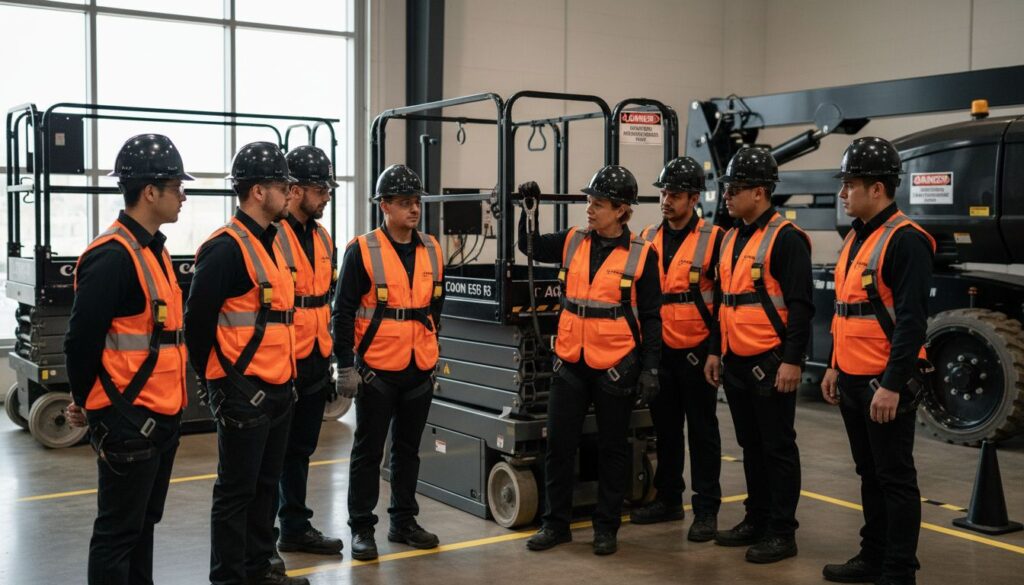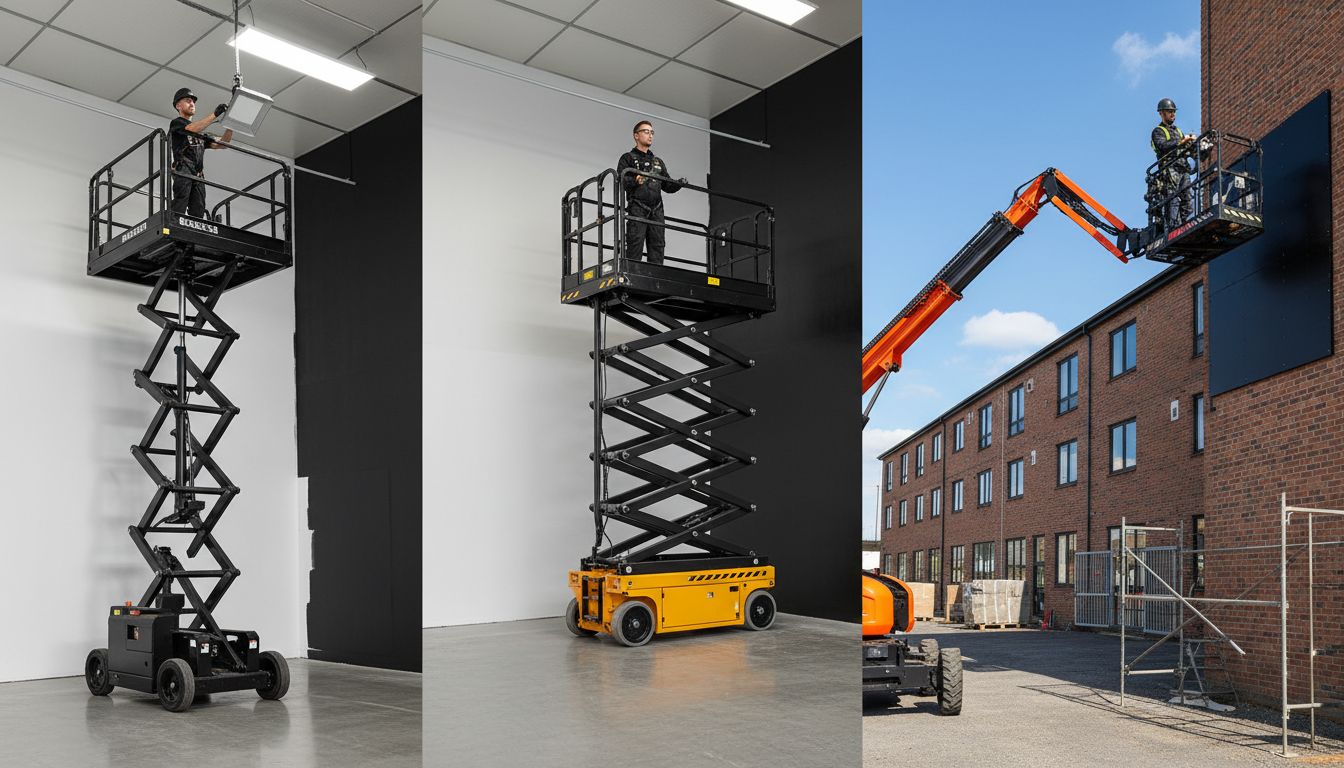
Every year, around 26 workers die from aerial lift incidents in construction alone. These sobering numbers highlight why safety matters every time someone leaves the ground in an aerial lift. Whether repairing lighting, painting, or building, the right training is the difference between a safe shift and a tragic accident. Understanding how aerial lifts work and what proper certification involves can save lives and help everyone go home at the end of the day.
| Point | Details |
|---|---|
| Importance of Training | Aerial lift training is crucial for ensuring safe operation and mitigating risks such as falls and electrocution. |
| Types of Aerial Lifts | Various aerial lift types, including work platforms, scissor lifts, and boom lifts, serve different heights and operational needs. |
| OSHA Regulations | Compliance with OSHA standards is mandatory, emphasizing training, equipment maintenance, and hazard identification. |
| Safety Benefits | Comprehensive training leads to reduced accident rates and increased worker confidence, enhancing overall operational efficiency. |
An aerial lift represents a specialized piece of mobile equipment designed to elevate workers safely and efficiently to various heights in industrial, construction, and maintenance environments. According to CDC, these powered mobile platforms are critical tools that transport personnel vertically while presenting inherent safety challenges such as fall hazards, electrocution risks, and potential equipment tip-over scenarios.
Training becomes absolutely essential because aerial lifts are not simple machines to operate. OSHA defines these devices as vehicle-mounted platforms that can include articulating boom platforms, extendable boom platforms, aerial ladders, and vertical towers. Proper training ensures operators understand the nuanced technical requirements and safety protocols necessary to prevent workplace accidents.
The core purposes of aerial lift training extend far beyond basic operational skills. Key objectives include:
Comprehensive training programs typically cover critical aspects like equipment inspection, load management, stability considerations, and situational awareness. By investing in thorough What is Aerial Lift Training? preparation, organizations can significantly reduce workplace risks and create a culture of safety that protects workers at elevated heights.
Aerial lifts are complex pieces of equipment with multiple specialized variants designed to meet diverse workplace elevation needs. Safety experts categorize these machines into several primary types, each with unique characteristics and operational requirements.
The most common types of aerial lifts include aerial work platforms, scissor lifts, and boom lifts. Aerial work platforms provide versatile vertical mobility for workers, typically featuring adjustable heights and platform configurations. Scissor lifts offer stable, vertical lifting with a distinctive crisscrossing metal framework that extends upward, ideal for tasks requiring consistent, balanced elevation. Boom lifts represent the most dynamic category, featuring extendable arms that can reach challenging angles and heights.
Key differences among these aerial lift types include:
Here’s a summary of the main types of aerial lifts and their key differences:
| Lift Type | Movement Type | Typical Maximum Height | Best Use Scenario |
|---|---|---|---|
| Aerial Work Platform | Vertical | 20-40 ft | Flexible indoor maintenance |
| Scissor Lift | Vertical | 20-50 ft | Stable, level surfaces |
| Boom Lift | Articulating/Vertical | 30-180 ft | Outdoor work, hard-to-reach areas |
Choosing the appropriate aerial lift depends on multiple factors such as worksite conditions, specific task requirements, and safety protocols. Organizations must carefully assess their unique needs when selecting an aerial lift, considering not just the immediate task but potential future applications.
 Understanding What is an Aerial Work Platform can help professionals make informed equipment selections that balance efficiency, safety, and operational flexibility.
Understanding What is an Aerial Work Platform can help professionals make informed equipment selections that balance efficiency, safety, and operational flexibility.
Workplace safety for aerial lift operations is governed by comprehensive OSHA regulations that establish critical standards for employee protection and equipment usage. OSHA mandates specific compliance requirements, including two primary regulatory codes: 29 CFR 1910.67 for general industry and 29 CFR 1926.453 for construction environments. These regulations provide detailed guidelines designed to protect workers from potential hazards associated with aerial lift operations.
The regulatory framework encompasses multiple critical components of workplace safety. Employers are required to implement extensive safety protocols that include comprehensive worker training, systematic equipment maintenance, and thorough hazard assessments. These standards are not mere suggestions but legally enforced requirements that directly impact workplace safety and potential legal liability.
Key OSHA regulatory requirements for aerial lift operations include:
Additionally, OSHA mandates specific retraining circumstances, such as when an accident occurs, new workplace hazards are discovered, or when operators transition to different types of aerial lift equipment. Understanding What is OSHA Compliance can help organizations navigate these complex regulatory requirements and ensure comprehensive workplace safety standards are consistently maintained.
Aerial lift operator training is a comprehensive process designed to equip workers with the critical knowledge and skills necessary for safe equipment operation. Safety experts emphasize that effective training programs must cover multiple critical dimensions of workplace safety, with certification typically requiring renewal every three years to ensure ongoing competency.
The core training curriculum encompasses a wide range of essential topics critical to safe aerial lift operation. Southern Utah University outlines key training components that include detailed explanations of potential workplace hazards such as electrical risks, fall dangers, and falling object threats. Operators learn comprehensive procedures for hazard recognition, avoidance of unsafe conditions, precise equipment operation techniques, and thorough pre-operation equipment inspections.
Essential training topics typically include:
The certification process involves both theoretical knowledge assessment and practical skill demonstration. How Forklift Certification Works can provide additional insights into the comprehensive evaluation methods used to ensure operators possess the necessary skills and understanding to operate aerial lifts safely and efficiently in diverse workplace environments.
Workplace aerial lift operations involve significant potential risks that demand comprehensive safety strategies and proactive management. Environmental Health and Safety reports a sobering statistic: approximately 26 construction workers lose their lives annually due to aerial lift incidents, highlighting the critical importance of thorough safety protocols and comprehensive training.
The primary risks associated with aerial lift operations include three major categories of potential incidents. Cornell University’s EHS Department identifies these critical hazards as falls, electrocutions, and equipment collapses or tip-overs. Each of these risks presents unique challenges that require specific mitigation strategies, technical knowledge, and precise operational procedures.
![]()
Key safety benefits of comprehensive aerial lift training include:
Organizations that prioritize comprehensive safety training not only protect their workforce but also significantly reduce potential financial and legal liabilities. How Forklift Certification Works provides additional insights into creating robust safety training programs that effectively address these critical workplace safety challenges.
Understanding the critical role of aerial lift training is the first step toward preventing costly accidents and protecting your workforce from falls and equipment hazards. This article highlights the importance of mastering safety protocols, hazard recognition, and OSHA standards to ensure every operator is fully prepared for the challenges posed by elevated work environments. If you are looking to bridge the gap between knowledge and practical skills, investing in certified training can dramatically reduce risks and improve compliance.

Take charge of your workplace safety today by exploring comprehensive programs at Forkliftacademy.com. With over 20 years of experience, we offer OSHA-compliant training and certification designed for aerial lifts and related equipment. Discover tailored solutions through our Forklift Safety Archives – Top Osha Forklift Certification and Forklift Certification Archives – Top Osha Forklift Certification that guarantee up-to-date knowledge and hands-on readiness. Don’t wait for an incident to force change; build confidence and competence now by visiting our site and getting started on the path to safer and more efficient aerial lift operations.
Aerial lift training is designed to equip operators with the necessary skills and knowledge to operate aerial lift equipment safely, preventing workplace injuries and ensuring compliance with safety regulations.
Key components typically include equipment-specific operational mechanics, hazard identification, personal protective equipment (PPE) requirements, emergency response procedures, and equipment inspection protocols.
Aerial lift operators are generally required to complete training upon initial employment and undergo refresher training every three years to ensure ongoing competency and safety awareness.
The primary risks include falls, electrocutions, and equipment collapses or tip-overs, making comprehensive training and safety protocols crucial for mitigating these hazards.